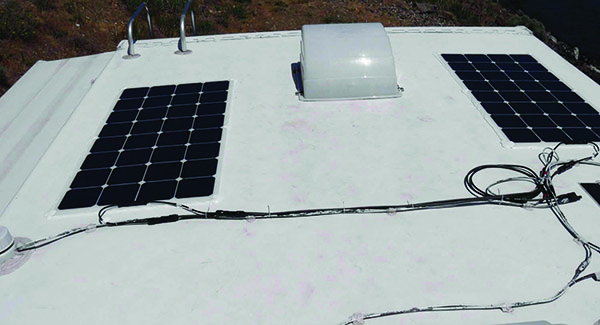Power from the People? A Long Way to Go
Wearable power generation and personal mobile power are intriguing. But do they threaten to upset current paradigms for generating electricity? The answer appears to be no.
“Power to the people” has long been a slogan of various political groups, left and right. But power from the people, harnessing the kinetic energy of human movement along with other notions of biological wearable power generation, has intrigued many in the electricity business for at least a decade. How is it going?
It’s been a slog. There’s little evidence that equipping humans with technologies for generating electricity will be a significant economic factor in the enormous world of electricity anytime soon. Some niche opportunities are possible, according to experts, but even that is problematic.
Military Tests
Take Bionic Power, a Canadian firm working with the U.S. military for several years to develop strap-on kinetic energy devices harnessing the power of soldiers as they walk through their daily movements (Figure 1). Two year ago, the company supplied its “PowerWalk Kinetic Energy Harvester” to the U.S. Army and Marine Corps, and to Canadian forces, for field tests. The Canadian trials of the Vancouver-based company’s technology netted a CA$1.16 million contract.
 |
|
1. The PowerWalk’s gearbox converts the knee’s rotational speed to a higher speed for efficient power generation and a generator converts the mechanical power produced into electrical power. A state-of-the-art power-conversion circuit then converts the electricity to recharge batteries. Courtesy: Bionic Power |
A year ago, the Army Times newspaper wrote, “Scientists with the Army’s communications and electronic research group are looking to the soldier’s own footsteps, and other means, to potentially increase battery life and lighten the load for increasingly tech-laden troops. Army researchers are forecasting that the battery load for a dismounted soldier could double by 2025, given the need for more sophisticated and powerful electronic systems being used by soldiers.”
That’s been Bionic Power’s target. CEO Yad Garcha, a former venture capitalist who formed the company, told POWER, “We produce 10–11 watts.” The company’s literature says, “Over the course of an hour, walking at a comfortable pace, users wearing a harvester on each leg can generate enough power to charge up to four smart phones.”
Unfortunately, Garcha said, the U.S. military recently concluded they need 10–11 watt-hours for 24 hours. “In the best case, we can only get them one-third of the power they need.” Other wearable power generating technologies, particularly solar backpacks, could only provide 3–4 watt-hours. “So, the U.S. Army chose not to deploy” wearable power technology, he said.
Garcha said, “The U.S. Army consumes more power than any other military,” in part because of the high technology soldiers carry on their bodies. “Soldiers get resupplied with fresh batteries every 48 hours and the military does not seem to have a culture of managing power aggressively.”
Novel Human Power Sources
Walking isn’t the only way to harvest electric power from the human body. A 2014 article published by Utility Dive observed that blood flow, working like a hydro plant, could also generate small amounts of power with a microturbine implanted in a person’s blood vessels. Researcher Alois Pfenninger at Israel’s Biorobotics and Biomechanics Lab tested three such devices. The most successful generated about 800 microwatts, enough to power a heart pacemaker.
Body heat can also produce electrical power. Duke University researchers have created “Power Felt,” a carbon nanotube fiber that can generate electricity from the temperature differential between a body and the ambient environment, providing insulation at the same time. The Duke researchers concluded it is possible to yield 1–2 watts of power, maybe enough to power a cell phone.
Then, there are, dare we mention them, urine and feces. Caitlyn Butler of the University of Massachusetts and other authors published a 2016 article, “Decentralized wastewater treatment using a bioelectrochemical system to produce methane and electricity,” describing a “microbial fuel cell pit latrine” with the potential to produce both low amounts of electricity and methane. However, these are not items one or two on the list of promising human power technologies.
The potentially most successful wearable or human power devices are small scale and still at an early stage of research and development. Many have medical uses. Many may never see the light of day. The Wearable Technologies website last year highlighted several. Among them are:
- ■ Washington State University researchers have developed a fuel cell that can use a body’s glucose (sugar) to produce enough power “to energize a biosensor attached to it.”
- ■ Hong Kong researchers have created “a yarn-shaped rechargeable zinc-ion battery that produces power when stretched, bent, cut, or washed with water.” It “could be woven into smart clothes filled with sensors and integrated into commercially manufactured textiles to power electronics, wearable displays, and medical implants.”
- ■ Carnegie Mellon scientists “have developed a new method for creating highly flexible, tattoo-like circuits that could one day power wearable devices.”
- ■ German researchers have created “next-generation metal-air batteries, which can be easily fabricated into flexible and wristband-like cells.”
- ■ Massachusetts Institute of Technology researchers “have developed a new system to power and communicate with devices implanted deep into the human body.”
- ■ Penn State University investigators have come up with a “wearable piezoelectric energy harvester” that can generate power from movement such as walking and jogging that could produce power for a personal health monitoring system. Piezoelectricity is the phenomenon that certain materials can generate an electric charge as a result of an applied mechanical stress. The best example is the burner igniters on many natural gas kitchen stoves.
- ■ A major Japanese printing company has come up with an “electric paper display,” which they claim “can be used to generate a display on battery-free Internet of Things devices compliant with the EnOcean standard.” EnOcean, according to Wikipedia, “is an energy harvesting wireless technology used primarily in building automation systems, and is also applied to other applications in industry, transportation, logistics and smart homes.”
Wearable Technologies exhibited at this November’s MEDICA trade show in Dusseldorf, Germany, in a joint pavilion where exhibitors were “showcasing which latest innovations and developments are available on the market today and which ones will become a part of our everyday life in the near future.”
Where will wearable power technologies fit into everyday life in the future? A 2016 Frost & Sullivan analysis, “Wearable Technologies in Clinical and Consumer Health,” suggests that the short-term future is in medicine. The report predicts a global market of $18.9 billion in 2020. That prediction does not focus entirely on wearable power in medicine, but includes “devices that can detect, store, and transmit vital parameters (such as heart rate, oxygen saturation, respiratory rate) measured in real time to report the overcoming of certain critical thresholds.” Many such devices are already in use, most often powered by external batteries, not by kinetic or biological forces.
The Roots of Wearable Power
Wearable power has a long history, going back to the 1970s and the advent of solar photovoltaic-powered wrist watches. The Japanese watch company Seiko was a pioneer, introducing a solar-powered watch in 1978—the LCD Solar Alarm Chronograph A156-5000. Since then, other watchmakers have offered solar-powered models, using a small solar panel to charge an onboard battery. Today, solar-powered watches are widely available, often at a price of about $100.
In early 2008, The New York Times carried an article headlined “Taking People Power to a New Level.” Somewhat breathlessly, building on an article in the American Association for the Advancement of Science journal Science, the piece proclaimed, “Some people exercise by power walking. But what if walking could actually provide electrical power? Researchers have developed an electrical generator mounted on the knee that turns walks into watts.”
Mobile, Not Wearable
Another approach to power from the people is produced in our moving technologies. Not large mobile power generators provided by a number of manufacturers but personal transportable power.
The most common example is regenerative braking, used in millions of electric vehicles, growing in popularity around the world. This technology converts the kinetic energy when you apply the brakes to slow your vehicle into useable electric power that can be stored onboard or routed to the electric motor. Otherwise, as has been the case for more than a century, the energy from braking is lost as heat.
When it comes to mobile power generation, solar appears to be the current best bet, particularly on tractor-trailer trucks. Last year, the North American Council for Freight Efficiency issued a report, “Solar for Trucks and Trailers,” that concludes, “Solar panels have applications both on the tractor and the trailer. The roof fairing of the tractor has historically gone unused and has ideal access to sunlight. The main uses of solar on tractors are to supplement battery [heating, ventilation, and air conditioning] systems and hotel loads without adding additional batteries.”
The truck industry group noted, “The fuel costs faced by the trucking industry are a significant part of the expense to operate a tractor-trailer in North America. Over the past decade, fuel has been as high as $0.65 per mile driven and then dropped to $0.34 by 2016. At these two points, fuel costs accounted for 39% and 21% of the total cost of operating a commercial vehicle, respectively.”
The group’s report adds, “Interest in solar panels is growing among fleet managers because truck batteries are often no longer able to meet the power needs of today’s trucks due to increased driver comfort demands, idle reduction regulations, and increased tracking requirements. However, because solar photovoltaic (PV) panels are so new to the trucking industry, many are unsure how to calculate payback when considering investing.”
 |
|
2. Mounting solar PV panels on tractor-trailer trucks and RVs is an innovative way to supplement power needs. The systems are generally not capable of supplying all loads, but can help to extend the availability of battery systems. Source: Flickr / RVwithTito |
Other mobile solar technologies are readily available, although less promising in scale than trucking applications. The most common are smaller-scale portable solar arrays for recreational vehicles (RVs, Figure 2). The website solarpowerrocks.com says, “If you travel often, and to remote locations, an RV solar panel will do wonders in terms of convenience and cost savings.” The site suggests two standard 100-W panels to keep an RV’s “deep-cycle batteries charged without plugging into an external power source.”
In the meantime, Bionic Power is offering its wearable generating technology as a medical device to assist children with mobility problems through a separate spinoff company. CEO Garcha said, “Imagine a condition where a kid can’t straighten the knees fully.” His technology could help that child by boosting the lift slowly, “lengthening the tendons to help the child be able to walk.” The technology will require U.S. Food and Drug Administration approval, but according to Garcha, it’s going into clinical trials. ■
—Kennedy Maize is a long-time energy journalist and a frequent contributor to POWER.